NCERT Solutions for Class 9 Science Class 9 Science Chapter 7 Motion provides detailed answers for all in-text and exercise Questions. These solutions contain an in-depth explanation of each topic involved in the chapter. Students studying in class 9 can access these solutions for free in PDF format.
All these solutions are prepared by expert teachers and updated for the current academic session. NCERT Solutions for Class 9 Science Chapter 7 Motion help students to understand the fundamental concepts given in class 9 Science textbook. We have prepared the answers to all the questions in an easy and well-structured manner. It helps students to grasp the chapter easily.
NCERT Class 9 Science Chapter 7 Motion Intext Questions (Solved)
PAGE NO. 74
Question 1: An object has moved through a distance. Can it have zero displacement? If yes, support your answer with an example.
Answer: Yes, zero displacement is possible if an object has moved through a distance. Suppose a body is moving in a circular path and starts moving from point A and it returns back at same point A after completing one revolution, then the distance will be equal to its circumference while displacement will be zero.
Question 2: A farmer moves along the boundary of a square field of side 10 m in 40 s. What will be the magnitude of displacement of the farmer at the end of 2 minutes 20 seconds from his initial position?
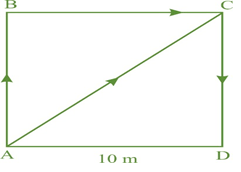
Answer: Given, side of the square field = 10 m
Therefore, perimeter = 10 m × 4 = 40 m
Farmer moves along the boundary in 40 second
Time = 2 minutes 20 second = 2 × 60 + 20 = 140 s
since, in 40 second farmer moves 40 m
Therefore, in 1 second distance covered by farmer = 40 ÷ 40 = 1m.
Hence, in 140 second distance covered by farmer = 1 × 140 m = 140 m
Now, number of rotation to cover 140 along the boundary
= Total distance ÷ perimeter
= 140 m ÷ 40 m
= 3.5 round
Thus after 3.5 round farmer will at point C (diagonally opposite to his initial position) of the field.

Question 3: Which of the following is true for displacement?
(a) It cannot be zero.
(b) Its magnitude is greater than the distance travelled by the object.
Answer: None of (a) and (b) are true.
(a) is false because the displacement of an object which travels a certain distance and comes back to its initial position is zero. Statement
(b) is false because the displacement of an object can be equal to, but never greater than the distance travelled.
PAGE NO. 76
Question 1: Distinguish between speed and velocity
Answer: Speed has only magnitude while velocity has both magnitude and direction. So speed is a scalar quantity but velocity is a vector quantity.
Question 2: Under what condition(s) is the magnitude of average velocity of an object equal to its average speed?
Answer: The magnitude of average velocity of an object will be equal to its average speed in the condition of uniform velocity in a straight line motion.
Question 3: What does the odometer of an automobile measure?
Answer: In automobiles, odometer is used to measure the distance.
Question 4: What does the path of an object look like when it is in uniform motion?
Answer: In the case of uniform motion, the path of an object will look like a straight line.
Question 5: During an experiment, a signal from a spaceship reached the ground station in five minutes. What was the distance of the spaceship from the ground station? The signal travels at the speed of light, that is, 3×108 ms-1 .
Answer: Here we have, speed = 3 × 108 m/s
Time = 5 minute = 5 × 60 s = 300 s
Using, Distance = Speed × Time
⇒ Distance = 3 × 108 × 300 m
⇒ Distance = 900 × 108 m
⇒ Distance = 9.0 × 1010 m
PAGE NO. 77
Question 1: When will you say a body is in (i) uniform acceleration? (ii) non-uniform acceleration?
Answer: (i) A body is said in uniform acceleration when its motion is along a straight line and its velocity changes by equal magnitude in equal interval of time.
(ii) A body is said in non-uniform acceleration when its motion is along a straight line and its velocity changes by unequal magnitude in equal interval of time.
Question 2: A bus decreases its speed from 80 km/h to 60 km/h in 5 s. Find the acceleration of the bus.
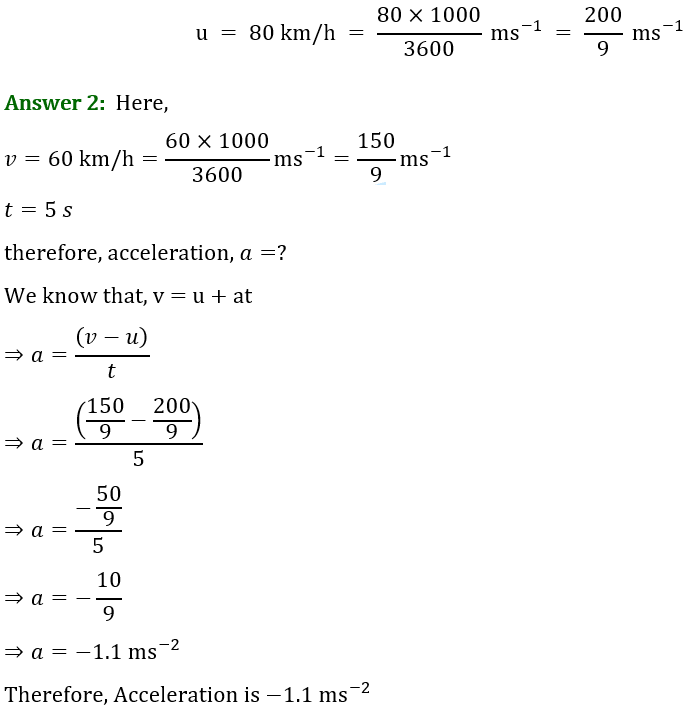
Question 3: A train starting from a railway station and moving with uniform acceleration attains a speed of 40 km/h in 10 minutes. Find its acceleration.
Answer: Here we have,
Initial velocity, u = 0 m/s
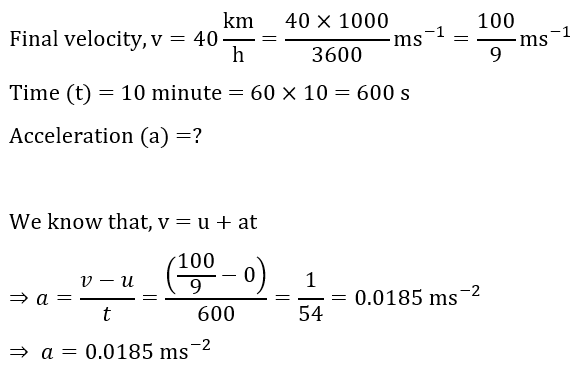
PAGE NO. 81
Question 1: What is the nature of the distance-time graphs for uniform and non-uniform motion of an object?
Answer :
- The slope of the distance-time graph for an object in uniform motion is straight line.
- The slope of the distance-time graph for an object in non-uniform motion is not a straight line.
Question 2: What can you say about the motion of an object whose distance-time graph is a straight line parallel to the time axis?
Answer: When the slope of the distance-time graph is a straight line parallel to the time axis, the object is stationary.
Question 3: What can you say about the motion of an object if its speed-time graph is a straight line parallel to the time axis?
Answer: When the graph of a speed-time graph is a straight line parallel to the time axis, the object is moving with constant speed.
Question 4: What is the quantity which is measured by the area occupied below the velocity-time graph?
Answer: The quantity of distance is measured by the area occupied below the velocity-time graph.
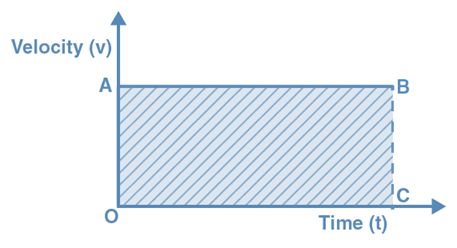
PAGE NO. 82
Question 1: A bus starting from rest moves with a uniform acceleration of 0.1ms–2 for 2 minutes. Find (a) the speed acquired, (b) the distance travelled.
Answer: Here we have,
Initial velocity (u) = 0 m/s
Acceleration (a) = 0.1ms–2
Time (t) = 2 minute = 120 seconds
(a) The speed acquired:
We know that, v = u + at
⇒ v = 0 + 0.1 × 120 m/s
⇒ v = 12 m/s
Thus, the bus will acquire a speed of 12 m/s after 2 minute with the given acceleration.
(b) The distance travelled:
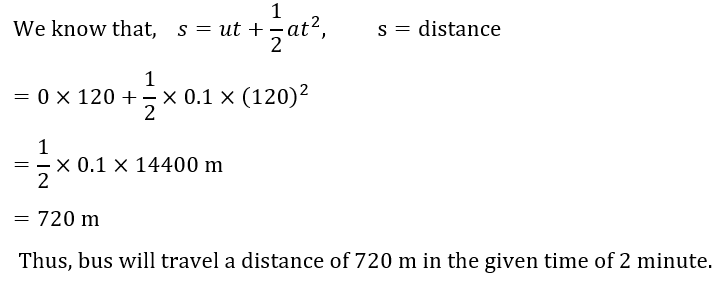
Question 2: A train is travelling at a speed of 90 km/h. Brakes are applied so as to produce a uniform acceleration of – 0.5 m/s2. Find how far the train will go before it is brought to rest.
Answer: Here we have,

Final velocity, v = 0 m/s
Acceleration, a = – 0.5 m/s2
Distance travelled (s) = ?
Using, v2 = u2 + 2as

Therefore, the train will go 625 m before it brought to rest.
Question 3: A trolley, while going down an inclined plane, has an acceleration of 2 cm/s2. What will be its velocity 3 s after the start?
Answer: Here we have,
Initial velocity, u = 0 m/s
Acceleration (a) = 2 cm/s2 = 0.02 m/s2
Time (t) = 3 s
Final velocity, v = ?
We know that,
v = u + at
⇒ v = 0 + 0.02 × 3 m/s
⇒ v = 0.06 m/s
Therefore, the final velocity will be 0.06 m/s after start.
Question 4: A racing car has a uniform acceleration of 4 m/s2. What distance will it cover in 10 s after start?
Answer: Here we have,
Acceleration, a = 4 m/s2
Initial velocity, u = 0 m/s
Time, t = 10 s
Distance covered (s) =?
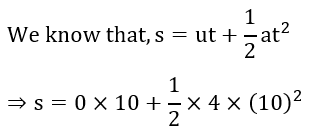
⇒ s = 2 × 100 m
⇒ s = 200 m
Thus, the racing car will cover a distance of 200 m after the start in 10 s with given acceleration.
Question 5: A stone is thrown in a vertically upward direction with a velocity of 5 m/s. If the acceleration of the stone during its motion is 10 m/s2 in the downward direction, what will be the height attained by the stone and how much time will it take to reach there?
Answer: Here we have,
Initial velocity (u) = 5 m/s
Final velocity (v) = 0 m/s
Acceleration (a) = – 10 m/s2
Height, i.e. Distance, s =?
Time (t) taken to reach the height =?
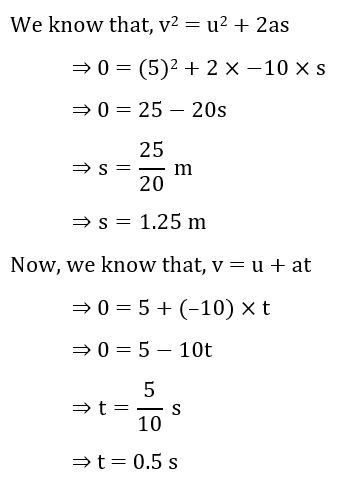
Thus, the stone will attain a height of 1.25 m and the time taken to attain the height is 0.5 s.
CBSE Class 9 Science Motion Exercise Questions and Answers
Question 1: An athlete completes one round of circular track of diameter 200 m in 40 sec. What will be the distance covered and the displacement at the end of 2 minutes 20 sec?
Answer: Time taken = 2 min 20 sec = 140 sec.
Radius, r = 100 m.
In 40 sec the athlete complete one round.
So, in 140 sec the athlete will complete = 140 ÷ 40 = 3.5 round.
Now, Distance covered in 140 sec = 2πr×3.5

= 2200 m.
At the end of his motion, the athlete will be in the diametrically opposite position. Displacement = diameter = 200 m.
Question 2: Joseph jogs from one end A to another end B of a straight 300 m road in 2 minutes and 30 sec and then turns around and jogs 100 m back to point C in another 1 minute. What are Joseph’s average speeds and velocities in jogging.
(a) from A to B
(b) from A to C?
Answer: For motion from A to B: Distance covered = 300 m Displacement = 300 m.
Time taken = 150 sec.
(a) We know that,
Average speed = Total distance covered ÷ Total time taken
= 300 m ÷ 150 sec
= 2 ms-1
Average velocity = Net displacement ÷ time taken
= 300 m ÷ 150 sec
= 2 ms-1
(b) For motion from A to C:
Distance covered = 300 + 100 = 400 m.
Displacement = AB – CB
= 300 – 100
= 200 m.
Time taken = 2.5 min + 1 min
= 3.5 min
= 210 sec.
Therefore,
Average speed = Total distance covered ÷ Total time taken
= 400 ÷ 210
= 1.90 ms-1.
Average velocity = Net displacement ÷ time taken
= 200 m ÷ 210 sec
= 0.952ms-1.
Question 3: Abdul, while driving to school, computes the average speed for his trip to be 20 kmh-1. On his return trip along the same route, there is less traffic and the average speed is 30 km/h. What is the average speed of Abdul’s trip?
Answer: Let one side distance = km.
Time taken for forward trip at a speed of 20 km/h = Distance / Speed = 20 h.
Time taken in return trip at a speed of 30 km/h = 30 h.
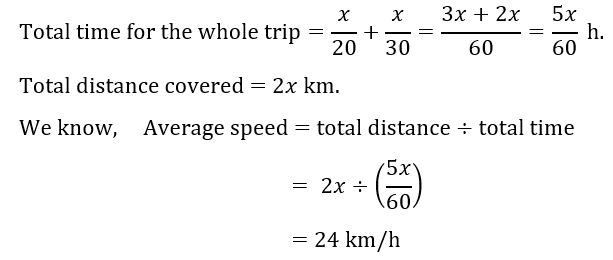
Question 4: A motor boat starting from rest on a lake accelerates in a straight line at a constant rate of 3.0 ms-2 for 8.0 s. How far does the boat travel during this time?
Answer: Here, u = 0 m/s
a = 3 ms-2
t = 8 s
Using, s = ut + ½ at2
⇒ s = 0 × 8 + ½ × 3×82
⇒ s =96 m.
Question 5: A driver of a car travelling at 52 kmh-1 applies the brakes and accelerates uniformly in the opposite direction. The car stops after 5 s. Another driver going at 34 kmh-1 in another car applies his brakes slowly and stops in 10 s. On the same graph paper, plot the speed versus time graphs for two cars. Which of the two cars travelled farther after the brakes were applied?
Answer: In in the following graph, AB and CD are the time graphs for the two cars whose initial speeds are 52 km/h(14.4 m/s) and 34 km/h(8.9 m/s), respectively.
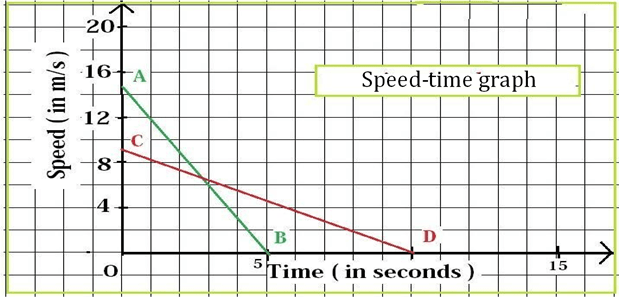
Distance covered by the first car before coming to rest
= Area of triangle AOB
= ½ × AO × BO
= ½ × 52 kmh-1 × 5 s
= ½ (52 × 1000 × 1/3600) ms-1 × 5 s
= 36.1 m
Distance covered by the second car before coming to rest
= Area of triangle COD
= ½ × CO × DO
= ½ × 34 km h-1 × 10 s
= ½ × (34 × 1000 × 1/3600) ms-1 ×10 s
= 47.2 m
Thus, the second car travels farther than the first car after they applied the brakes.
Question 6: Fig 8.11 shows the distance-time graph of three objects A, B and C. Study the graph and answer the following questions:
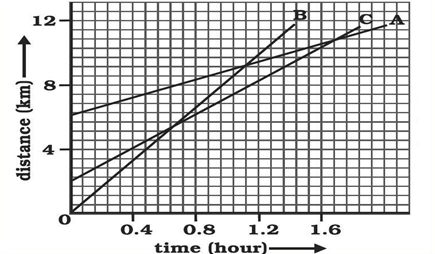
(a) Which of the three is travelling the fastest
(b) Are all three ever at the same point on the road?
(c) How far has C travelled when B passes A?
(d) How far has B travelled by the time it passes C?
Answer:
(a) B is travelling fastest as he is taking less time to cover more distance.
(b) All three are never at the same point on the road.
(c) Approximately 6 km. [as 8 – 2 = 6]
(d) Approximately 7 km. [as 7 – 0 = 7]
Question 7: A ball is gently dropped from a height of 20 m. If its velocity increases uniformly at the rate of 10ms-2, with what velocity will it strike the ground? After what time will it strike the ground?
Answer: Here, u = 0 m/s,
s = 20 m,
a = 10 ms-2,
v = ?,
t = ?
Using v2 – u2 = 2as
We have, v2 – 02 = 2 × 10 × 20
⇒ v2 = 20 × 20
⇒ v2 = 400
⇒ v = 20 ms-1.
Again we know
v = u +at
⇒ t = (v – u) ÷ a
⇒ t = (20 – 0) ÷ 10
⇒ t = 20 ÷ 10
⇒ t = 2 s.
Question 8: The speed – time graph for a car is shown in Figure:
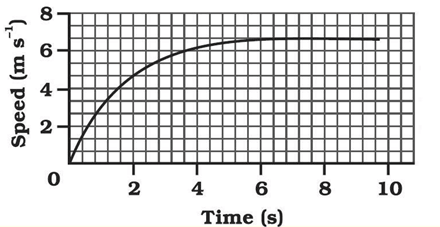
(a) Find how far does the car travel in the first 4 seconds. Shade the area on the graph that represents the distance travelled by the car during the period.
(b) Which part of the graph represents uniform motion of the car?
Answer: (a) The shaded area represents the displacement of the car over a time period of 4 seconds. It can be calculated as: (1/2)×4×6 = 12 meters. Therefore the car travels a total of 12 meters in the first four seconds.
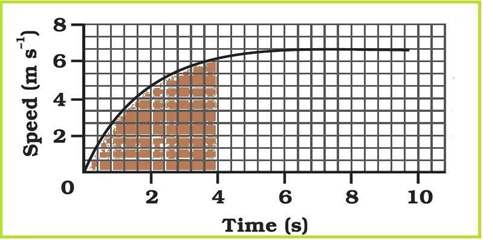
(b) After 6 seconds the car moves in uniform motion (at a speed of 6 m/s).
Question 9: State which of the following situations are possible and give an example of each of the following:
(a) an object with a constant acceleration but with zero velocity,
(b) an object moving in a certain direction with an acceleration in the perpendicular direction.
Answer: (a) Yes, a body can have acceleration even when its velocity is zero. When a body is thrown up at the highest point its velocity is zero but it has acceleration equal to the acceleration due to gravity.
(b) Yes, an acceleration moving horizontally is acted upon by acceleration due to gravity that acts vertically downwards.
Question 10: An artificial is moving in a circular orbit of radius 42250 km. Calculate its speed if it takes 24 hrs to revolve around the earth.
Answer: Here,
r = 42250 km = 42250000 m
T = 24 h = 24 × 60 × 60 s
Using , Speed, v = 2πr ÷ T
v = (2 × 3.14 × 42250000) ÷ (24 × 60 × 60) m/s
= 3070.9 m/s
= 3.07 km/s